How To Repair Removed Section Of Board And Tike In The Shower
This browser is no longer supported.
Upgrade to Microsoft Edge to accept reward of the latest features, security updates, and technical support.
Remove, delete, or restore work items in Azure Boards
Azure DevOps Services | Azure DevOps Server 2022 | Azure DevOps Server 2022 | TFS 2022 - TFS 2022
Piece of work items can live forever in your piece of work tracking data store. You never have to delete them. Still, y'all might want to ready a work item management process for one of the post-obit actions:
- Change state: Remove work items from appearing on backlogs and boards by irresolute the work item State to Remove or Cutting.
- Delete: Remove work items from backlogs, boards, and queries. Deleted work items are moved to a Recycle Bin. From the Recycle Bin, y'all tin restore or permanently delete them.
- Destroy: Permanently delete work items, deleting all data from the work tracking data store.
- Restore: Recover deleted work items, restoring them from the Recycle Bin.
- Change country: Remove work items from appearing on backlogs and boards by changing the piece of work particular State to Remove or Cut.
- Destroy: Permanently delete piece of work items, deleting all information from the piece of work tracking data store.
The ability to archive work items or projects isn't a supported feature at this time.
Prerequisites
- To remove, modify, or delete work items, you must be a member of the Contributors group or accept the following permissions set up to Permit.
- Remove work items: Take the View work items in this node and Edit piece of work items in this node Area Path permissions set to Allow.
- Delete work items and Restore work items: Have the Delete and restore piece of work items project-level permission set to Permit. Also, to delete or restore work items, you must have Basic access or higher. Users with Stakeholder admission can view the contents of the Recycle Bin, but can't restore or permanently delete items in the bin.
- To remove, modify, or delete work items, y'all must be a member of the Contributors group or take the following permissions gear up to Allow.
- Remove work items: Have the View work items in this node and Edit work items in this node Area Path permissions set to Permit.
- To Restore or destroy piece of work items or Delete or destroy work items (az boards CLI), you must be a member of the Project Administrators group or have the Delete work items in this project project-level permission set to Allow.
- To Restore or destroy piece of work items, yous must be a member of the Projection Administrators grouping or have the Delete work items in this projection project-level permission set to Allow.
- To Restore or destroy work items or Destroy work items (witadmin CLI), you must be a member of the Project Administrators group or have the Delete work items in this project project-level permission set to Let.
- To Destroy piece of work items (witadmin CLI), you must be a fellow member of the Project Administrators grouping or have the Delete piece of work items in this project project-level permission set to Allow.
Note
By default, for TFS 2022.1 and before versions, the Contributors grouping has Delete work items in this projection set to Non set. This setting causes the Contributors grouping to inherit the value from the closest parent that has it explicitly prepare.
For a simplified view of permissions assigned to built-in groups, see Permissions and access.
Notation
Users with Stakeholder access for a public project have full access to all work tracking features just like users with Basic access. For details, meet Stakeholder admission quick reference.
Of import

To view the content bachelor for your platform, make sure that you select the right version of this article from the version selector which is located above the tabular array of contents. Feature support differs depending on whether you lot are working from Azure DevOps Services or an on-premises version of Azure DevOps Server.
To learn which on-premises version y'all are using, see What platform/version am I using?
Remove or delete multiple work items
You lot can act on private piece of work items or bulk alter several work items.
From the web portal, y'all tin can multi-select several work items from a backlog or query results page. You can also do a majority update using the associated feature. To delete or restore several work items at the same time, come across Bulk modify work items.
Remove piece of work items
By changing the State of a piece of work item to Removed, y'all finer remove it from a backlog or lath view (product, portfolio, and sprint backlogs, Kanban lath, and Taskboards). The Removed state corresponds to the Removed workflow category state. If you lot ascertain custom workflow states, any state you map to the Removed workflow category state volition act in a similar way.
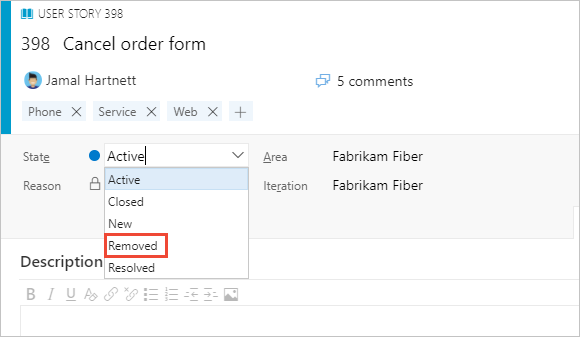
To cause removed items to not show upwards in queries, you must add a clause that filters on the Land field.
Note
The Removed state isn't supported with the Bones process. It is but supported with the Agile, Scrum, and CMMI process piece of work item types. The Basic process is available when you lot add together a projection to Azure DevOps Services or Azure DevOps Server 2022 Update one.
Delete piece of work items
Deleted work items won't announced in your backlogs, boards, or queries. Deleted items are moved to a Recycle Bin from which you can recover them if needed. To delete a test example, test plan, or other test-related work particular types, see Delete examination artifacts.
-
You can delete a piece of work item from within the work item form, past multi-selecting work items from a backlog or query results page, or from a Kanban board or Taskboard.
To delete a single work item, open the work item, choose the
 Actions, and select Delete.
Actions, and select Delete.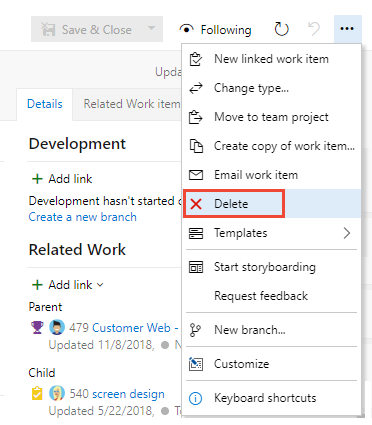
To delete several work items, multi-select them from a backlog or a query results listing and and so cull the
 actions icon and select Delete.
actions icon and select Delete.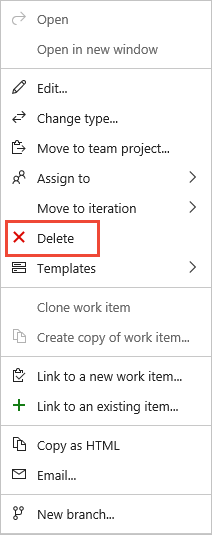
To delete a work item from your Kanban or taskboard, choose the
 actions icon of the bill of fare and select Delete.
actions icon of the bill of fare and select Delete.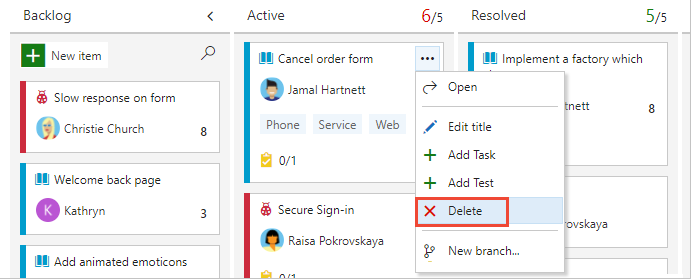
-
Confirm you lot want to actually delete the item(s).
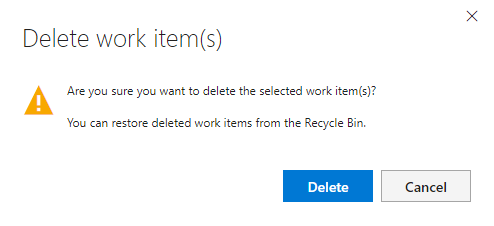
Note
The Delete and Recycle Bin features are available from TFS 2022.2 and subsequently versions.
-
You tin delete a piece of work detail from within the piece of work item form, or by multi-selecting piece of work items from a excess or query results page.
To delete a unmarried work item, open the work item, choose the
 Actions, and select Delete.
Actions, and select Delete.
To delete several piece of work items, multi-select them from a backlog or a query results list. And so, cull the
 actions icon and select Delete.
actions icon and select Delete.
Yous can also delete work items from your Kanban or taskboard.

Or, you can drag them to the
 (Recycle bin). You can only access the (Recycle bin) from the Piece of work hub.
(Recycle bin). You can only access the (Recycle bin) from the Piece of work hub. -
Ostend you want to really delete the particular(s).

Note
The Delete work items confirmation dialog for on-premises Azure DevOps may indicate in that location are auto-delete settings (disabled). There are no settings y'all can enable or disable. There is only a background process which permanently deletes work items that have been set to delete.
Restore or destroy work items
You restore deleted work items or permanently delete them from the spider web portal Recycle Bin.
-
Choose Boards>Work Items and then choose the Recycle Bin.

If y'all don't encounter the Recycle Bin option, choose More commands … and cull it from the menu of options.
Note
Deleted test artifacts won't appear in the Recycle Bin and can't be restored. Deletion of test artifacts deletes the selected examination artifact and all of its associated child items, such as child test suites, test points beyond all configurations, testers (the underlying exam case work item doesn't go deleted), test results history, and other associated history.
-
A new browser tab opens with the query that lists work items added to the Recycle Bin.
-
Select the items y'all want to restore and so choose Restore.

Optionally, you can choose to permanently delete the items.
Annotation
You can't open work items that have been moved to the Recycle Bin. Also, you'll only come across the Permanently delete option if your Permanently delete work items project-level permission is gear up to Let.
-
Ostend your pick.
Yous restore deleted piece of work items from the web portal Recycle Bin.
Note
The Delete and Recycle Bin features crave TFS 2022.2 or subsequently version.
-
Cull Work>Backlogs or Work>Queries and and then choose the Recycle Bin.

A new browser tab opens with the query that lists piece of work items added to the Recycle Bin.
-
Select the items you want to restore and then cull Restore.

Optionally, y'all can choose to permanently delete the items.
Notation
Y'all can't open up work items that have been moved to the Recycle Bin. Also, you'll simply see the Permanently delete option if your Permanently delete work items project-level permission is set to Allow.
-
Ostend your selection.
Delete or destroy work items from the command line
Y'all tin delete or destroy a work detail with the az boards work-item delete command. To get started, see Get started with Azure DevOps CLI.
Note
Yous can restore work items you delete, just you lot tin't restore work items yous choose to destroy.
az boards work-item delete --id [--destroy] [--org] [--project] [--yep] Parameters
- id: Required. The ID of the piece of work item.
- destroy: Optional. Permanently delete this work item.
- org: Azure DevOps organization URL. Y'all tin can configure the default organization using
az devops configure -d organization=ORG_URL. Required if not configured as default or picked up usinggit config. Example:--org https://dev.azure.com/MyOrganizationName/. - project: Name or ID of the project. You tin can configure the default project using
az devops configure -d project=NAME_OR_ID. Required if non configured as default or picked upwardly usinggit config. - yes: Optional. Don't prompt for confirmation.
Example
The post-obit control permanently deletes the bug with the ID 864 and doesn't prompt y'all for confirmation.
az boards work-detail delete --id 864 --destroy --yes Destroy piece of work items from the command line
Use the witadmin destroywi command to permanently remove piece of work items from the data store. A permanent delete means all information in the work tracking data store is deleted and cannot be restored nor reactivated.
Note
Deleting work items from the witadmin control line is deprecated for TFS 2022.2 and afterward versions, and non supported for Azure Boards cloud service.
Open a Command Prompt window where the latest version of Visual Studio is installed and modify the directory to where the witadmin.exe tool has been installed.
For case, you would change to the following directory for TFS 2022. (For other versions, see Remove piece of work items permanently (witadmin destroywi)).
%programfiles(x86)%\Microsoft Visual Studio\2018\Professional\Common7\IDE\CommonExtensions\Microsoft\TeamFoundation\Team Explorer
For example, you lot would change to the post-obit directory for TFS 2022. (For other versions, see Remove piece of work items permanently (witadmin destroywi)).
%programfiles(x86)%\Microsoft Visual Studio\2017\Professional person\Common7\IDE\CommonExtensions\Microsoft\TeamFoundation\Team Explorer
On a 32-scrap edition of Windows, replace %programfiles(x86)% with %programfiles%.
The witadmin control-line tool installs with whatever version of Visual Studio or Team Explorer. You can access this tool by installing the free version of Visual Studio Community.
-
To delete several piece of work items, enter the server name and directory path to the drove. For example:
witadmin destroywi /collection:http://TFSServerName:8080/tfs/DefaultCollection /id:12,15,23 -
To delete a single work particular, enter the ID as shown:
witadmin destroywi /collection:http://TFSServerName:8080/tfs/DefaultCollection /id:2003
How to delete and restore actions work
When you delete a piece of work particular, the following actions occur:
- Generates a new revision of the work item
- Updates the Changed Past/Changed Date fields to back up traceability
- Preserves the work item completely, including all field assignments, attachments, tags, and links
- Causes the work particular to get non-queryable and, equally such, won't announced in any work tracking experience, query result, or report
- Updates charts correctly. The CFD, velocity, burndown, and lightweight charts are updated to remove deleted work items
- Removes piece of work tracking extensions
- Preserves trend data except for the latest value
- Removes the work particular from the data warehouse/cube similar to as if it was permanently removed.
When y'all restore a work item, the following actions occur:
- Causes a new revision of the work item to exist made
- Updates the Changed By/Changed Date fields to back up traceability
- Becomes queryable
- All fields remain unchanged
- History contains two new revisions, i for deletion, and 1 for restore
- Reattaches piece of work tracking extensions
- Updates charts correctly. The CFD, velocity, burndown, and lightweight charts are updated to include the restored work items
- Restores trend data
- Adds the work detail back to the data warehouse/cube
- Sets the surface area or iteration path fields to the root node if the previous surface area path or iteration paths were deleted.
Related articles
- Best tool to add, update, and link work items
- View and add piece of work items using the Work Items page
- Delete test artifacts
- Prepare permissions and access for work tracking
- Modify project-level permissions
- Stakeholder access quick reference
- All-time tool to add, update, and link piece of work items
- View and add piece of work items using the Work Items page
- Remove work items permanently (witadmin destroywi)
- Delete examination artifacts
- Fix permissions and admission for work tracking
- Change project-level permissions
- Stakeholder admission quick reference
Feedback
Submit and view feedback for
Source: https://docs.microsoft.com/en-us/azure/devops/boards/backlogs/remove-delete-work-items?view=azure-devops
Posted by: joneswarry1979.blogspot.com


0 Response to "How To Repair Removed Section Of Board And Tike In The Shower"
Post a Comment